key JAGUAR XJ6 1994 2.G User Guide
[x] Cancel search | Manufacturer: JAGUAR, Model Year: 1994, Model line: XJ6, Model: JAGUAR XJ6 1994 2.GPages: 521, PDF Size: 17.35 MB
Page 317 of 521
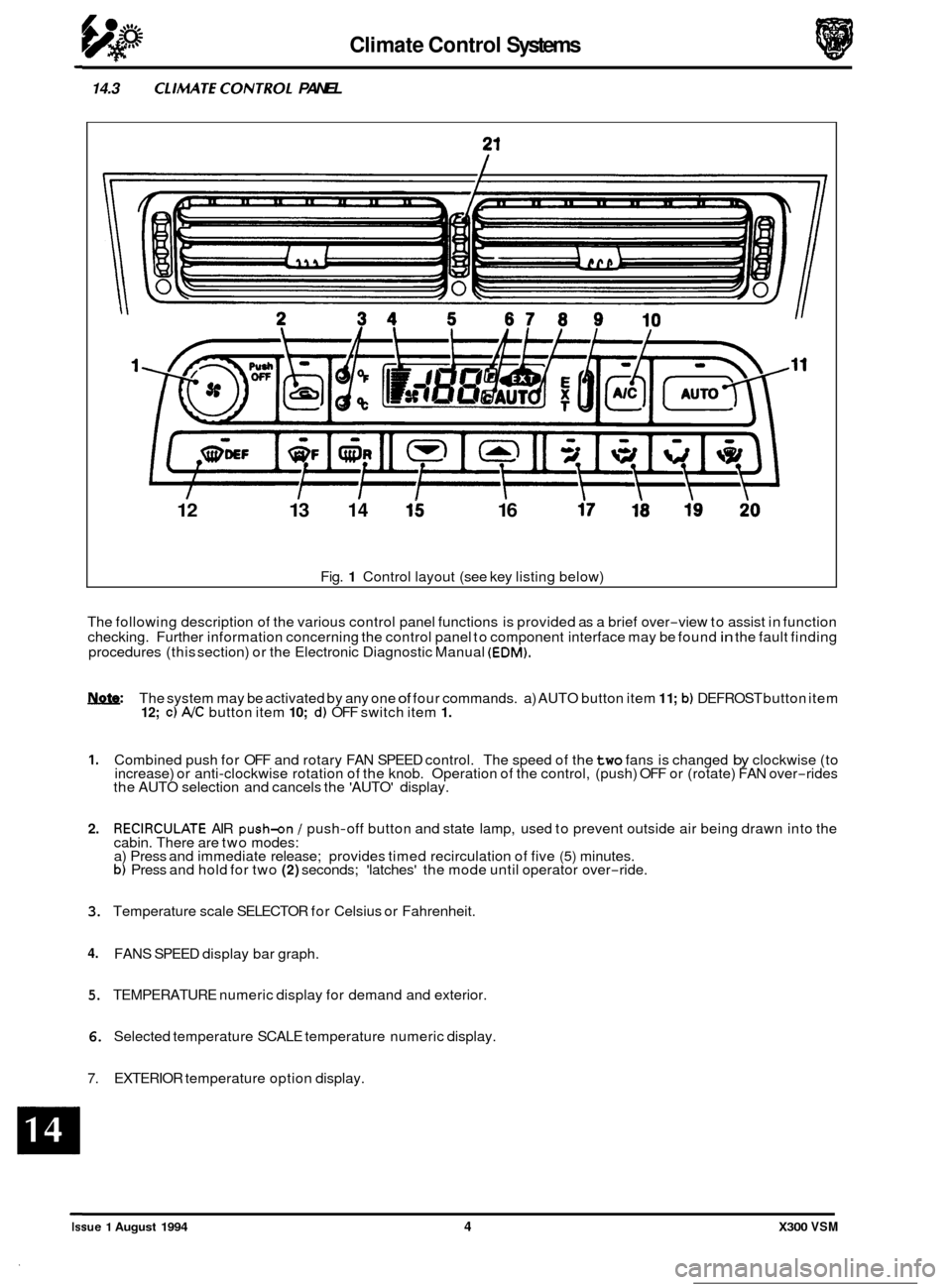
Climate Control Systems
14.3 CLIMATECONTROL PANEL
12 13 14 15 16
Fig. 1 Control layout (see key listing below)
The following description of the various control panel functions is provided as a brief over
-view to assist in function
checking. Further information concerning the control panel to component interface may be found in the fault finding
procedures (this section) or the Electronic Diagnostic Manual (EDM).
Iynfe: The system may be activated by any one of four commands. a) AUTO button item 1 1; b) DEFROST button item 12; c) NC button item 10; d) OFF switch item 1.
1. Combined push for OFF and rotary FAN SPEED control. The speed of the two fans is changed by clockwise (to
increase) or anti-clockwise rotation of the knob. Operation of the control, (push) OFF or (rotate) FAN over-rides
the AUTO selection and cancels the 'AUTO' display.
2. RECIRCULATE AIR push-on / push-off button and state lamp, used to prevent outside air being drawn into the
cabin. There are two modes:
a) Press and immediate release; provides timed recirculation of five
(5) minutes. b) Press and hold for two (2) seconds; 'latches' the mode until operator over-ride.
3. Temperature scale SELECTOR for Celsius or Fahrenheit.
4. FANS SPEED display bar graph.
5. TEMPERATURE numeric display for demand and exterior.
6. Selected temperature SCALE temperature numeric display.
7. EXTERIOR temperature option display.
Issue 1 August 1994 4 X300 VSM
Page 330 of 521
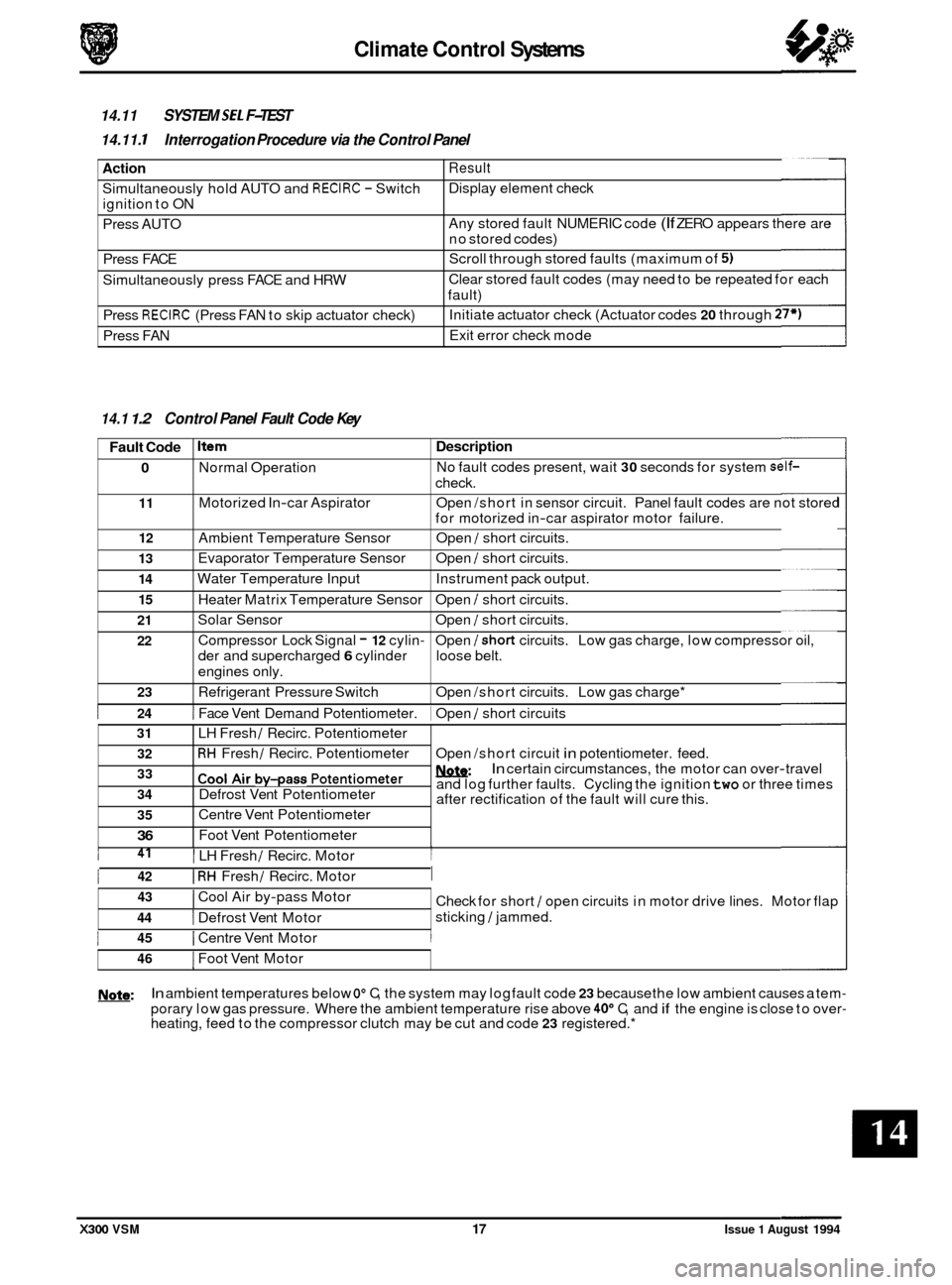
Climate Control Systems
Action
Simultaneously hold AUTO and RECIRC - Switch
ignition to ON
Press AUTO
Press FACE
Simultaneously press FACE and HRW
Press
RECIRC (Press FAN to skip actuator check)
Press FAN
14.11 SYSTEM SE1 F-TEST
14.11. I Interrogation Procedure via the Control Panel
Result
Display element check
Any stored fault NUMERIC code
(If ZERO appears there are
no stored codes)
Scroll through stored faults (maximum of
5)
Clear stored fault codes (may need to be repeated for each
fault)
Initiate actuator check (Actuator codes
20 through 27*)
Exit error check mode
Fault Code
0
11
12
13
14
15
21
22
0
23
14.1 1.2 Control Panel Fault Code Key
Item Description
Normal Operation No
fault codes present, wait 30 seconds for system self-
check.
Motorized In
-car Aspirator Open /short in sensor circuit. Panel fault codes are not stored
for motorized in
-car aspirator motor failure.
Ambient Temperature Sensor Open
/ short circuits.
Evaporator Temperature Sensor Open
/ short circuits.
Water Temperature Input Instrument pack output.
Heater Matrix Temperature Sensor Open
/ short circuits.
Solar Sensor Open
/ short circuits.
Compressor Lock Signal
- 12 cylin- Open /short circuits. Low gas charge, low compressor oil,
der and supercharged
6 cylinder loose belt.
engines only.
Refrigerant Pressure Switch Open /short circuits. Low gas charge*
31
32
33
34
35
36 0
I 24 1 Face Vent Demand Potentiometer. 1 Open / short circuits
LH Fresh
/ Recirc. Potentiometer
RH Fresh / Recirc. Potentiometer
cool ~i~ by-pass potentiometer
Defrost Vent Potentiometer
Centre Vent Potentiometer
Foot Vent Potentiometer Open
/short circuit
in potentiometer. feed.
w: and log further faults. Cycling the ignition two or three times
after rectification of the fault will cure this.
In certain circumstances, the motor can over-travel
43
44
I Defrost Vent Motor
I Cool Air by-pass Motor
I 41 I LH Fresh / Recirc. Motor I
Check for short / open circuits in motor drive lines. Motor flap
sticking
/ jammed.
1 42 I RH Fresh / Recirc. Motor I
1 45 I Centre Vent Motor I
46 I Foot Vent Motor
w: In ambient temperatures below Oo C, the system may log fault code 23 because the low ambient causes a tem-
porary low gas pressure. Where the ambient temperature rise above 40" C, and if the engine is close to over- heating, feed to the compressor clutch may be cut and code 23 registered.*
X300 VSM 17 Issue 1 August 1994
Page 345 of 521
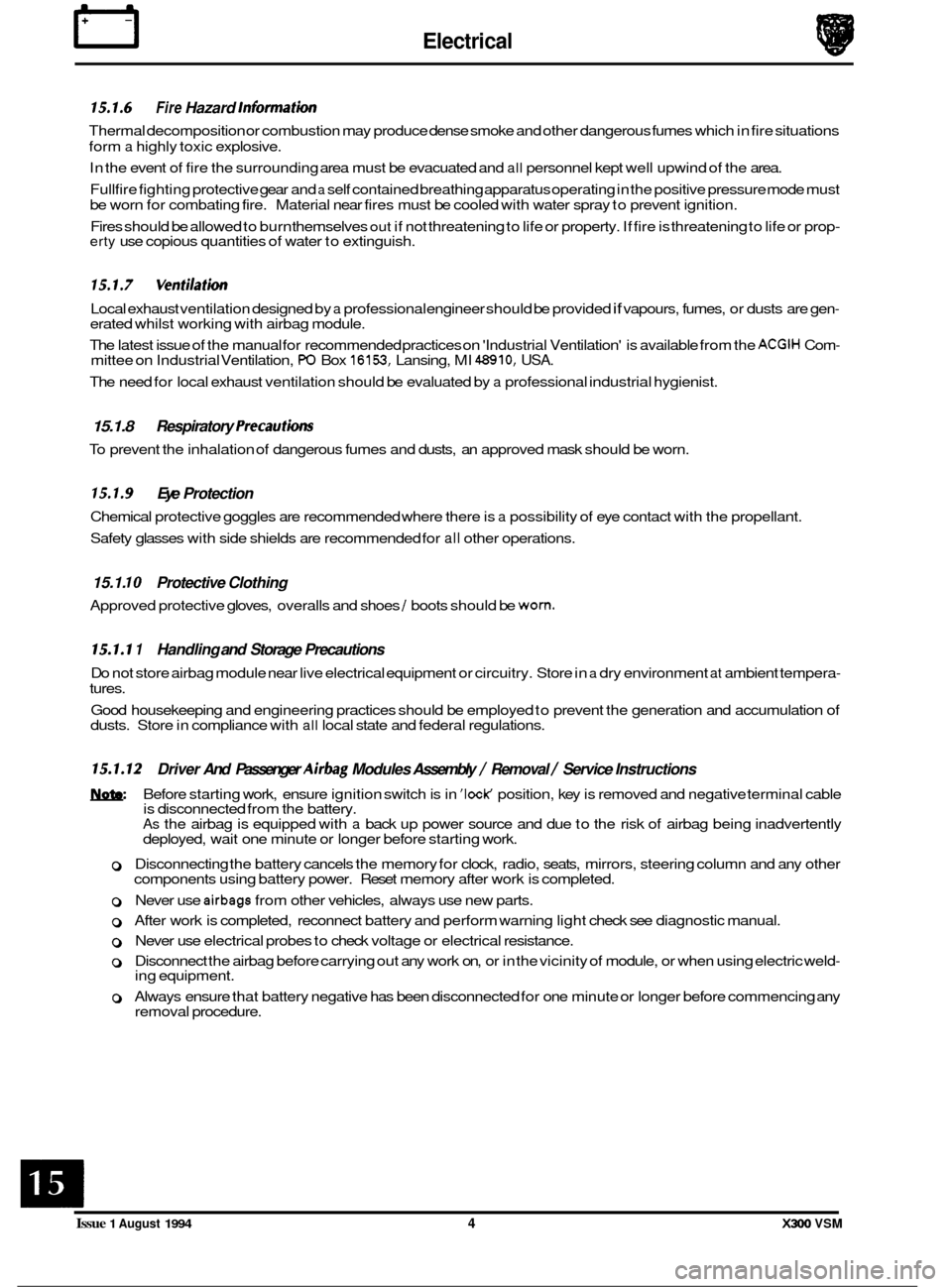
rl Electrical
15.1.6 Fire Hazard Infonnath
Thermal decomposition or combustion may produce dense smoke and other dangerous fumes which in fire situations
form
a highly toxic explosive.
In the event of fire the surrounding area must be evacuated and
all personnel kept well upwind of the area.
Full fire fighting protective gear and
a self contained breathing apparatus operating in the positive pressure mode must
be worn for combating fire. Material near fires must be cooled with water spray to prevent ignition.
Fires should be allowed to burn themselves
out if not threatening to life or property. If fire is threatening to life or prop- erty use copious quantities of water to extinguish.
15.1.7 Ventilath
Local exhaust ventilation designed by a professional engineer should be provided if vapours, fumes, or dusts are gen- erated whilst working with airbag module.
The latest issue of the manual for recommended practices on 'Industrial Ventilation' is available from the
ACGIH Com- mittee on Industrial Ventilation, PO Box 16153, Lansing, MI 48910, USA.
The need for local exhaust ventilation should be evaluated by a professional industrial hygienist.
15.1.8 Respiratory Precauth
To prevent the inhalation of dangerous fumes and dusts, an approved mask should be worn.
15.1.9 Eye Protection
Chemical protective goggles are recommended where there is a possibility of eye contact with the propellant.
Safety glasses with side shields are recommended for
all other operations.
15.1. I0 Protective Clothing
Approved protective gloves, overalls and shoes / boots should be worn.
15.1.1 1 Handling and Storage Precautions
Do not store airbag module near live electrical equipment or circuitry. Store in a dry environment at ambient tempera-
tures.
Good housekeeping and engineering practices should be employed to prevent the generation and accumulation of
dusts. Store in compliance with
all local state and federal regulations.
15.1.12 Driver And Passenger Airbag Modules Assembly / Removal / Service Instructions
Before starting work, ensure ignition switch is in 'IocK position, key is removed and negative terminal cable
is disconnected from the battery.
As the airbag is equipped with a back up power source and due to the risk of airbag being inadvertently
deployed, wait one minute or longer before starting work.
0 Disconnecting the battery cancels the memory for clock, radio, seats, mirrors, steering column and any other
components using battery power. Reset memory after work is completed.
0 Never use airbags from other vehicles, always use new parts.
0 After work is completed, reconnect battery and perform warning light check see diagnostic manual.
0 Never use electrical probes to check voltage or electrical resistance.
0 Disconnect the airbag before carrying out any work on, or in the vicinity of module, or when using electric weld- ing equipment.
0 Always ensure that battery negative has been disconnected for one minute or longer before commencing any
removal procedure.
EB
Issue 1 August 1994 4 X300 VSM
Page 364 of 521
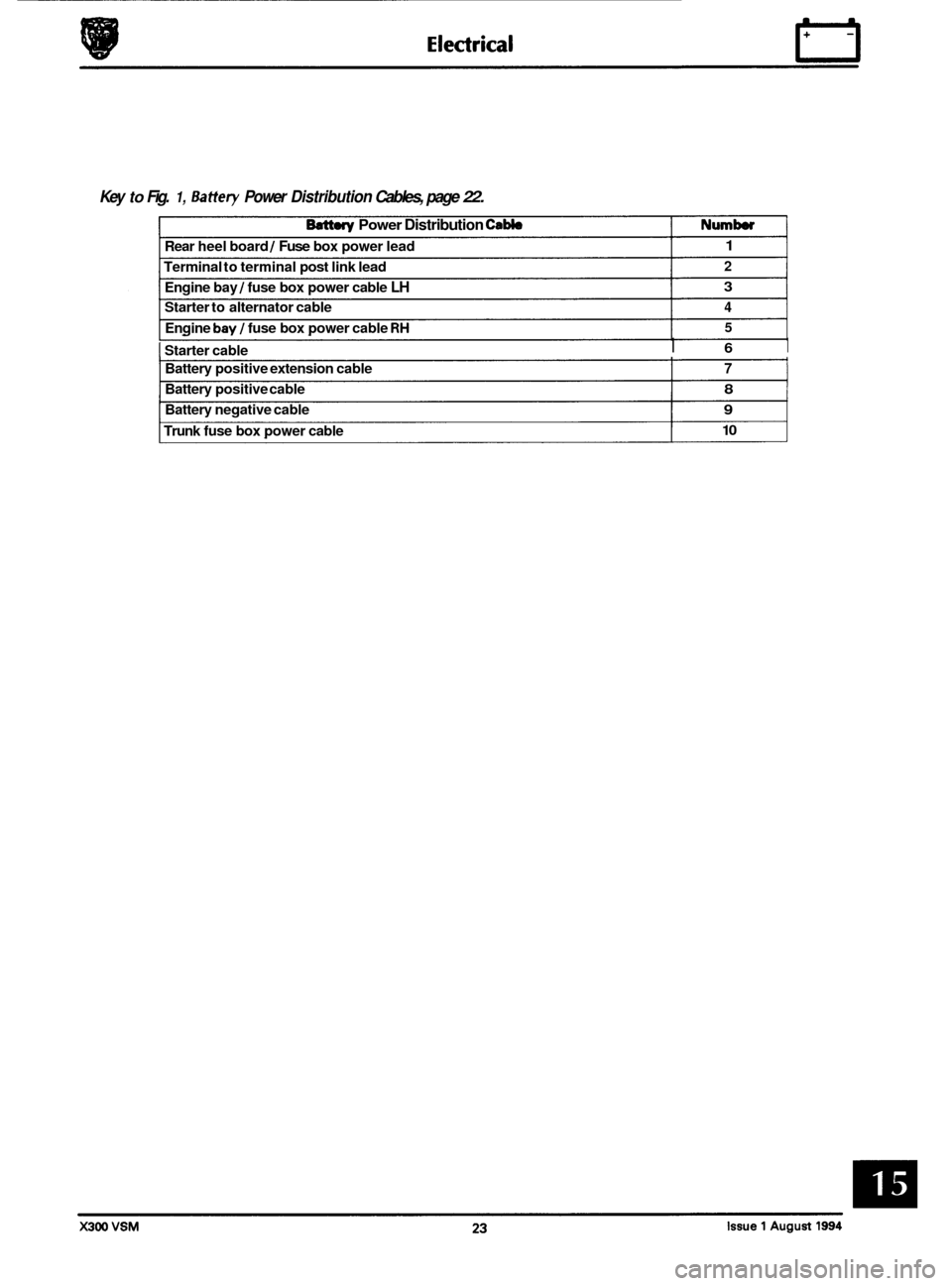
Key to Fig. 1, Battery Power Distribution Cables, page 22.
Rear heel board 1 Fuse box power lead 1
Terminal to terminal post link lead 2
Engine bay 1 fuse box power cable LH 3
Starter to alternator cable 4
Engine bay 1 fuse box power cable RH 5
Batt.ry Power Distribution Cabb Numb
1 Starter cable I 6 I
Battery positive extension cable 7
Battery positive cable 8
Battery negative cable 9
Trunk fuse box power cable 10
Page 368 of 521

Key to Fig. 1, Link Harnesses, page 32.
X300 VSM 27 Issue 1 August 1994
Page 370 of 521
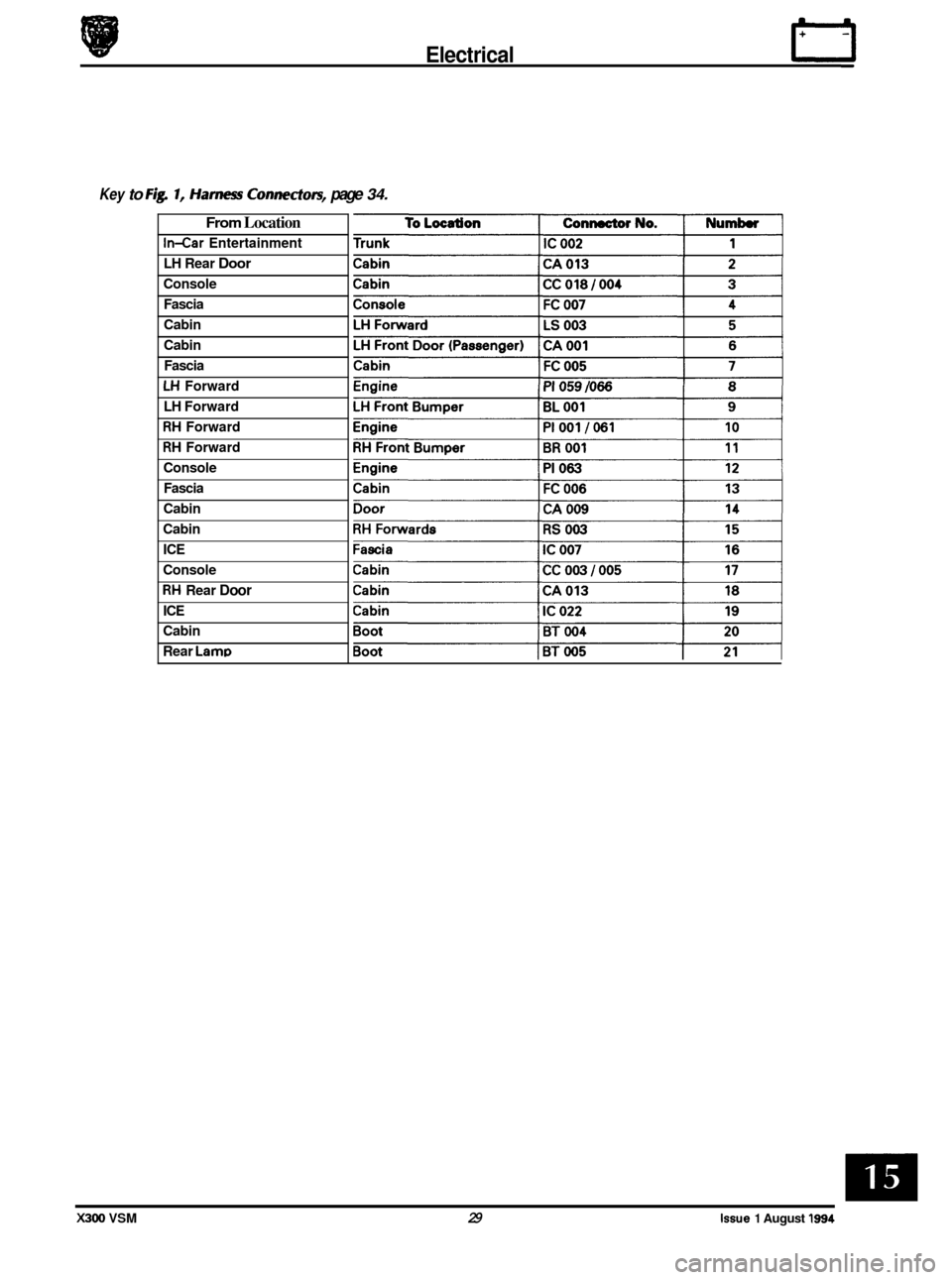
Electrical rl
Key to Fig 1, Hamess Connecton, page 34.
From Location
In-Car Entertainment
LH Rear
Door
Console
Fascia
Cabin
Cabin
Fascia
LH Forward
LH Forward
RH Forward
RH Forward
Console Fascia
Cabin
Cabin ICE
Console
RH Rear Door
ICE
Cabin
Rear
LamD
X300 VSM 29 Issue 1 August 1994
Page 372 of 521

Electrical rl
Key to Fig 1, Motors & Solenoids, page 36.
Filler Cap (Solenoid)
X300 VSM ~~ Issue 1 August 31
- 1994
Page 374 of 521
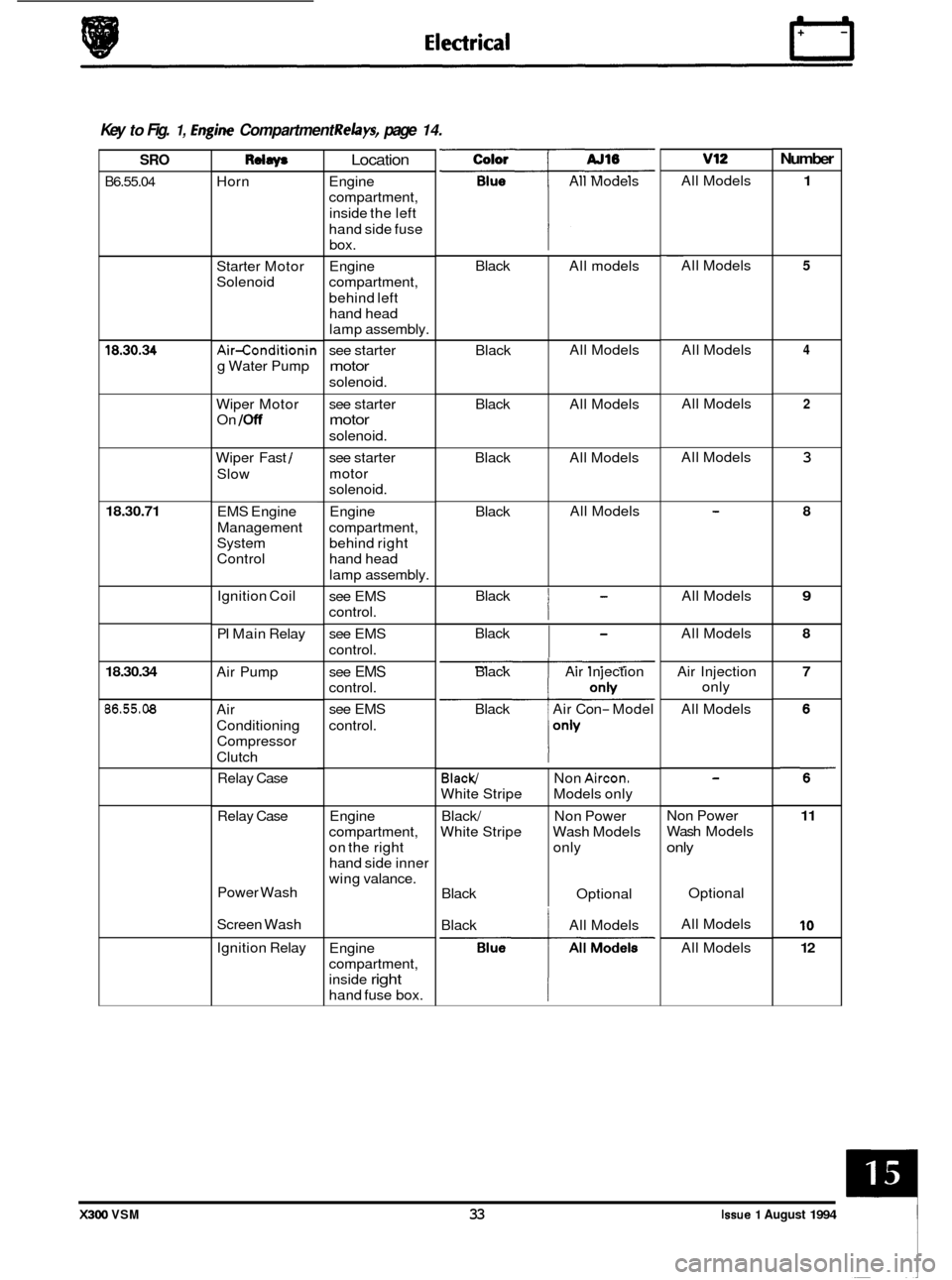
Black
Black
Black All
models
All Models
All Models
Black
Black All
Models
All Models
Black/
White Stripe
Black/
White Stripe
Black Non
Aircon.
Models
only
Non Power
Wash Models
only
Optional
0 Key to Fig. 1, hgine Compartment Relays, page 14.
Number v12 Color
All Models
SRO
B6.55.04
Rdaw
Horn
Location
Engine
compartment,
inside the left
hand side fuse box.
Engine
compartment,
behind left hand head
lamp assembly.
see starter
motor
solenoid. All
Models
1 ~~
All
Models 5 Starter Motor
Solenoid
4 All Models
All Models 18.30.34 Air-conditionin
g Water Pump
Wiper Motor
On
/Off
2 see starter
motor
solenoid.
see starter
motor
solenoid. All
Models
3 Wiper Fast /
Slow
18.30.71 Engine
compartment, behind right
hand head
lamp assembly. 8 EMS Engine
Management
System
Control
Black
I
All Models 9 Ignition Coil
PI Main Relay see
EMS
control.
see EMS
control. Black
I
All
Models 8
Air Pump 7 see EMS
control.
see EMS
control. Black
Air Injection
Black Air Con
- Model Air
Injection
only
All Models
18.30.34
86.55.08 Air
Conditioning
Compressor
Clutch
Relay Case
Engine
compartment,
on the right
hand side inner
wing valance.
Relay
Case Non Power
Wash
Models
only
11
10
12
Power Wash
Screen Wash Optional
All Models
All Models
Black
All Models
Ignition Relay
Engine
compartment,
inside
right
hand fuse box.
X300 VSM 33 Issue 1 August 1994
Page 376 of 521
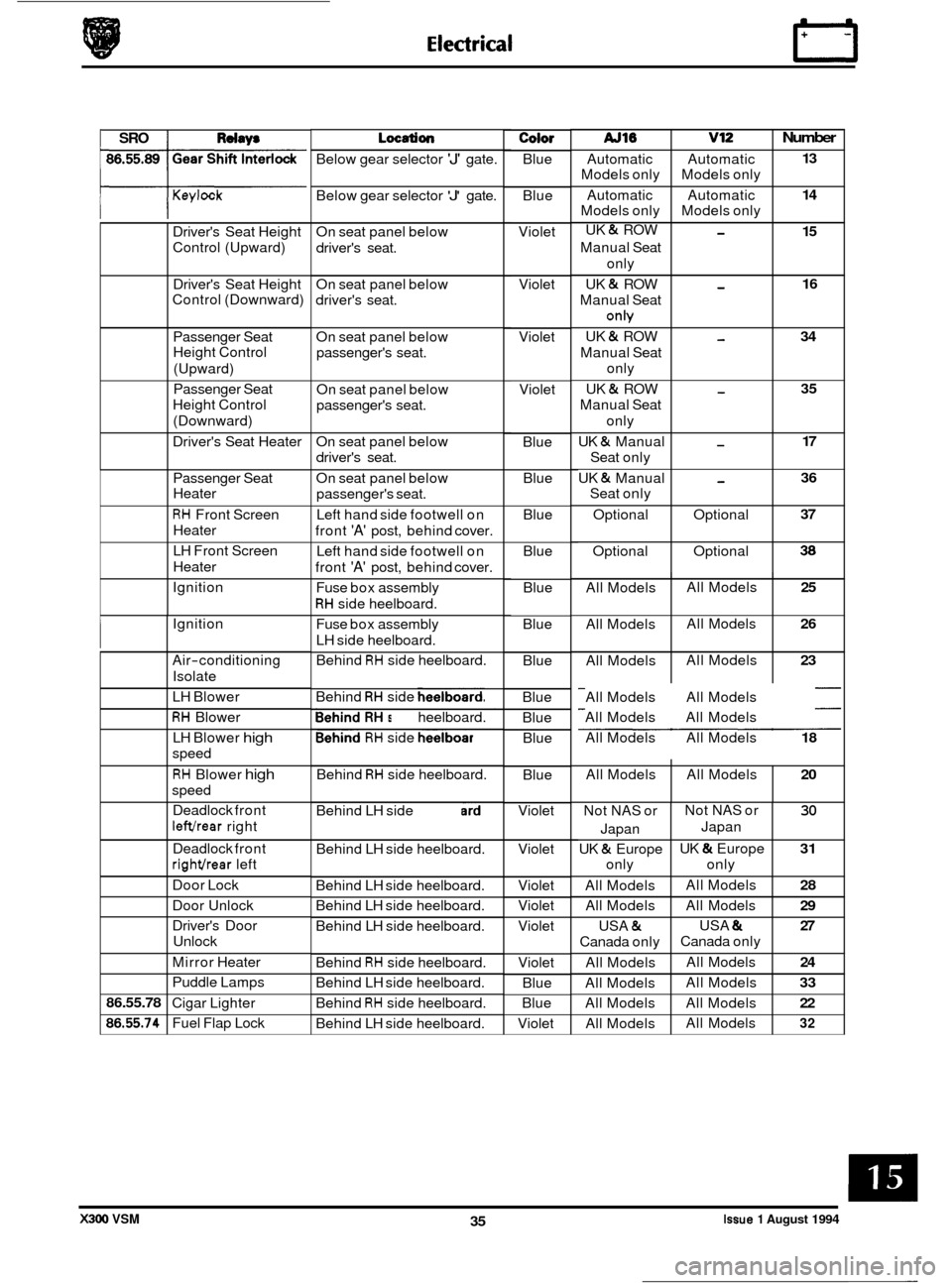
I SRO I Rdw* AJ16 v12
Automatic Automatic
Models only Models only
Automatic Automatic
Models only Models only
UK
& ROW -
Manual Seat
only
UK
& ROW -
Manual Seat
onh/
UK & ROW -
Manual Seat
only
Manual Seat
only
UK
& Manual -
Seat only
UK
& Manual -
Seat only
UK
& ROW -
Optional
Optional
Optional Optional
Keylock
Number
13
14
15
16
34
35
17
36
37
38
Driver's Seat Height
Control (Upward)
Driver's Seat Height
Control (Downward)
Passenger Seat
Height Control (Upward)
Passenger Seat
Height Control
(Downward)
Driver's Seat Heater
All Models
All Models
All Models
Passenger Seat
Heater
RH Front
Screen
Heater
LH Front Screen
Heater
Ignition All Models
25
All Models 26
All Models 23
Ignition
Air
-conditioning
Isolate
LH Blower
RH Blower
LH Blower
high
speed
RH Blower high
speed
Deadlock front
lefthear right All
Models All Models
20
Below gear selector 'J' gate.
Not NAS or
Japan
UK
& Europe
only
All Models
All Models
USA
&
Canada only
All Models
All Models
All Models
All Models
Below
gear selector
'J' gate.
Not NAS or
30
UK & Europe 31
All Models 28
All Models 29
USA & 27
All Models 24
All Models 33
All Models 22
All Models 32
Japan
only
Canada only
On
seat panel below
driver's seat.
86.55.78
86.55.74
On seat panel below
driver's seat.
Deadlock front
righthear left
Door Lock
Door Unlock
Driver's Door
Unlock
Mirror Heater
Puddle Lamps
Cigar Lighter
Fuel Flap Lock On
seat panel below
passenger's seat.
On seat panel below
passenger's seat.
On seat panel below
driver's seat.
On seat panel below
passenger's seat.
Left hand side footwell on
front
'A' post, behind cover.
Left hand side footwell on
front
'A' post, behind cover.
Fuse box assembly
RH side heelboard.
Fuse box assembly
LH side heelboard.
Behind
RH side heelboard.
Behind
RH side heelboard.
Behind RH side heelboard.
Behind
RH side heelboard.
Behind
RH side heelboard.
Behind LH side heelboard.
Behind LH side heelboard.
Behind LH side heelboard.
Behind LH side heelboard.
Behind LH side heelboard.
Behind
RH side heelboard.
Behind LH side heelboard.
Behind
RH side heelboard.
Behind LH side heelboard.
Color
Blue
Blue
Violet
Violet
Violet Violet Blue Blue
Blue
Blue
Blue
Blue
Blue
Blue
Blue Blue
Blue
Violet
Violet
Violet
Violet
Violet
Violet Blue
Blue
Violet All
Models All Models
All Models All Models
All Models All Models
18
X300 VSM 35 Issue 1 August 1994
Page 378 of 521
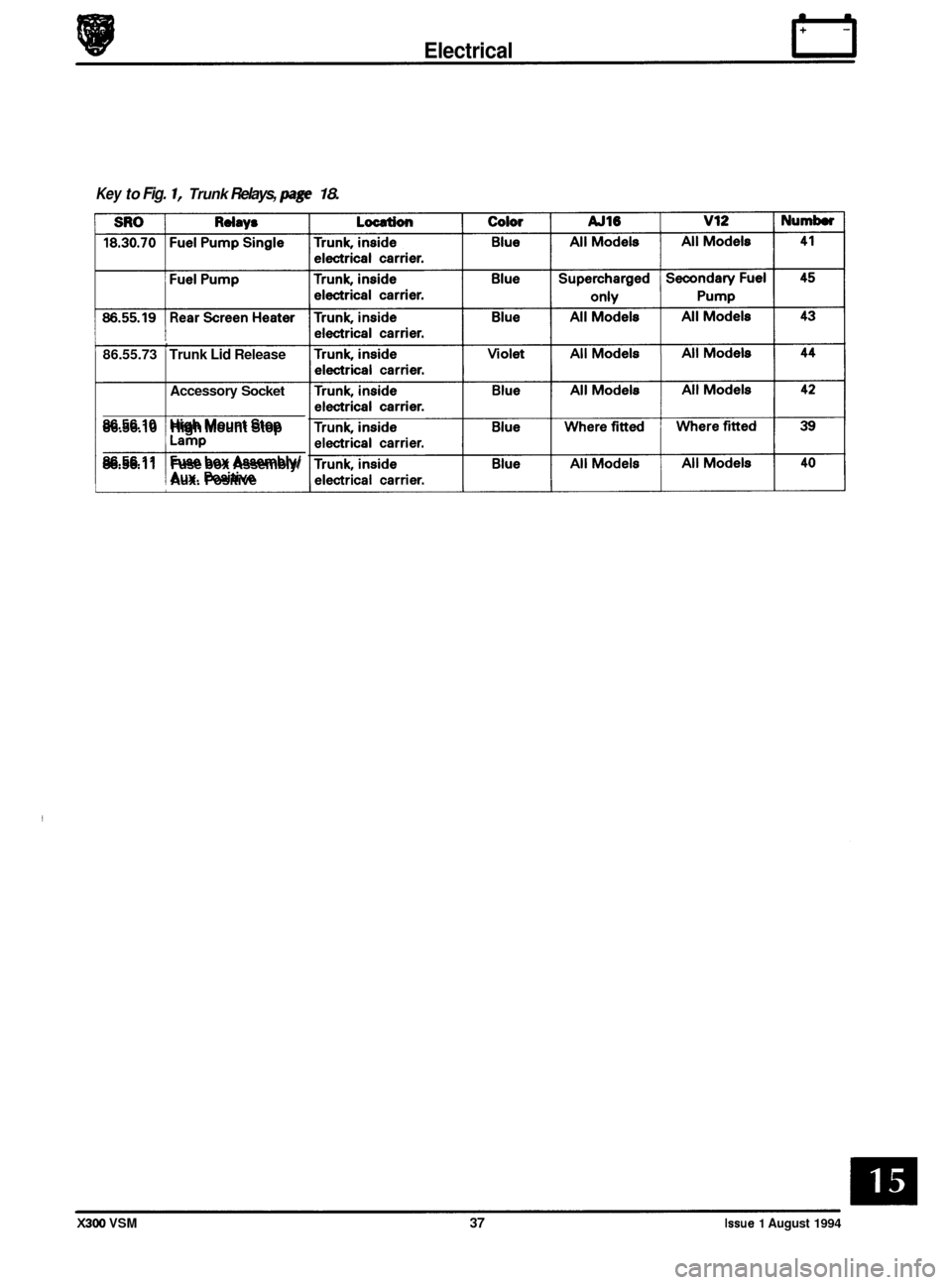
Electrical IT
Key to Fig. 1, Trunk Relays, page 18.
, 86.55.73 Trunk Lid Release
Accessory
Socket
86.56.10 High Mount Stop
86.56.11 Fuse box Assembly/
! Aux. Positive
X300 VSM 37 Issue 1 August 1994